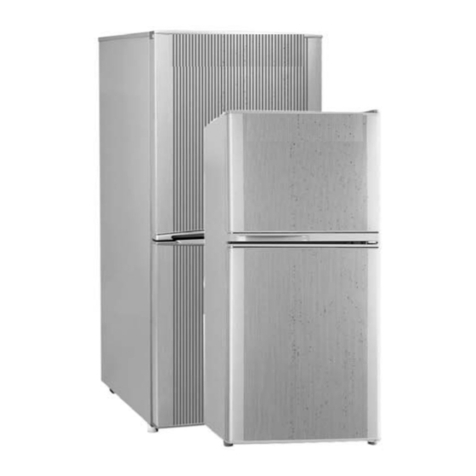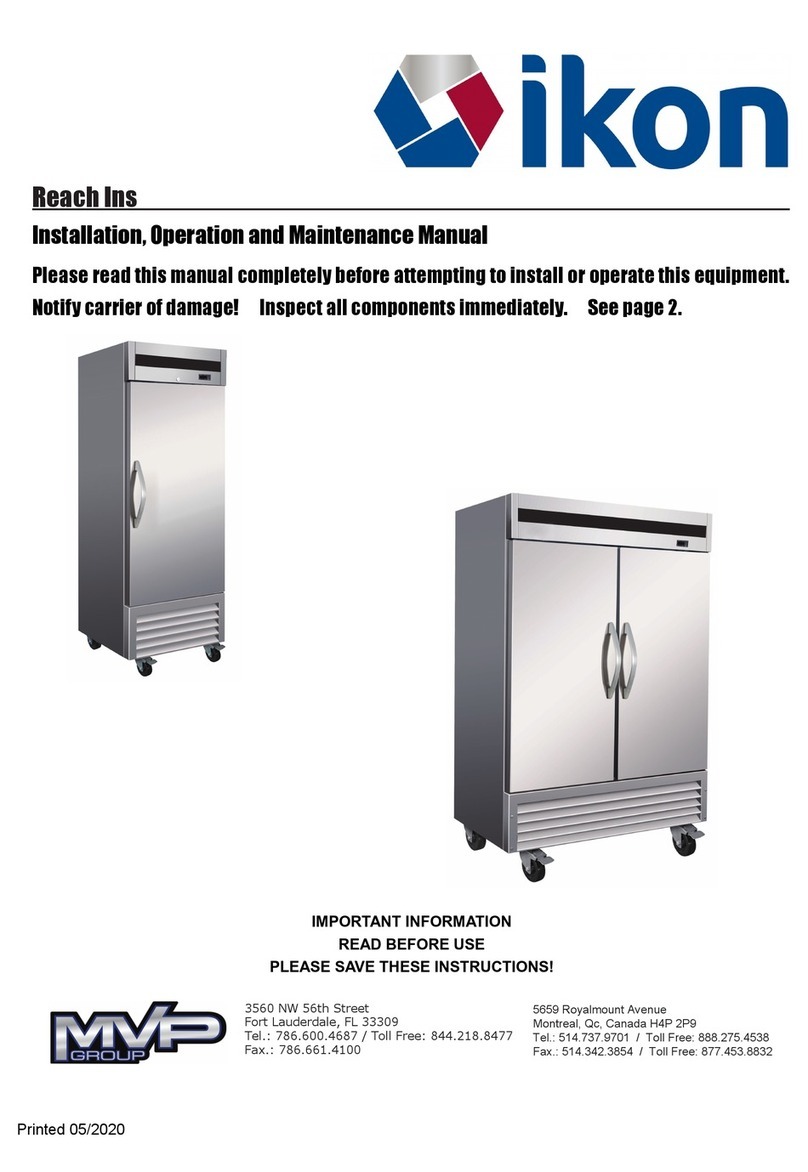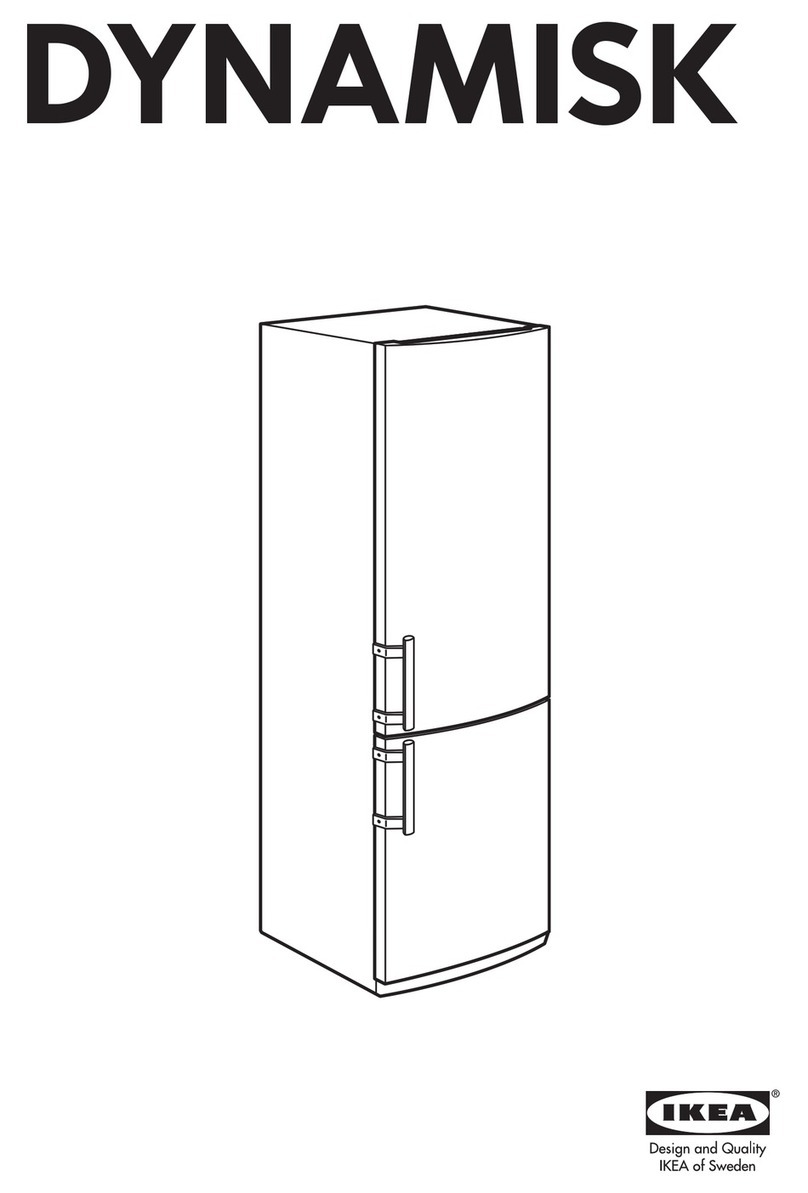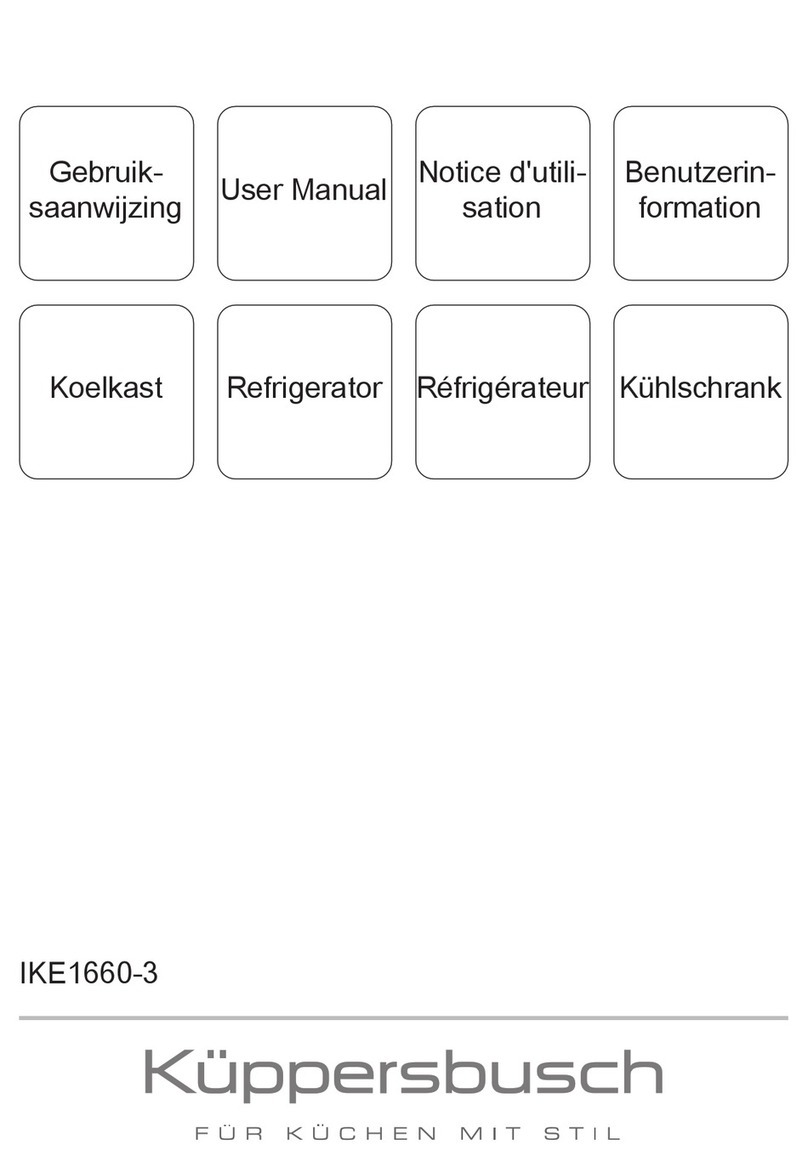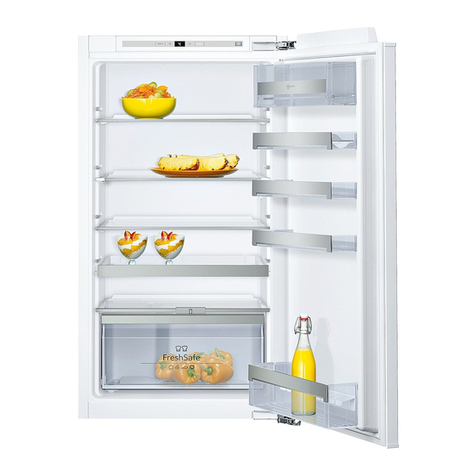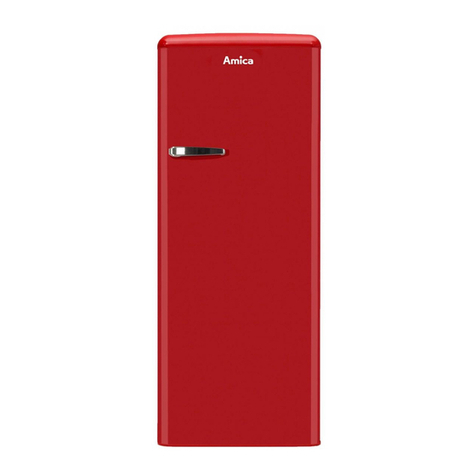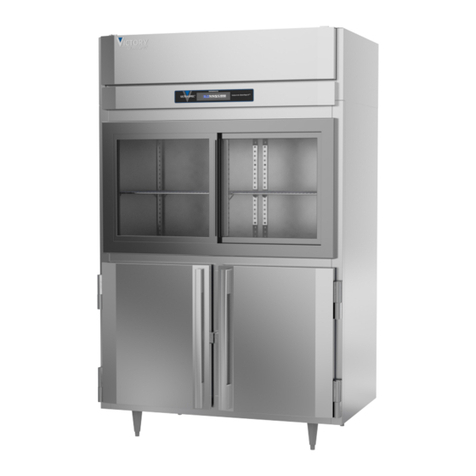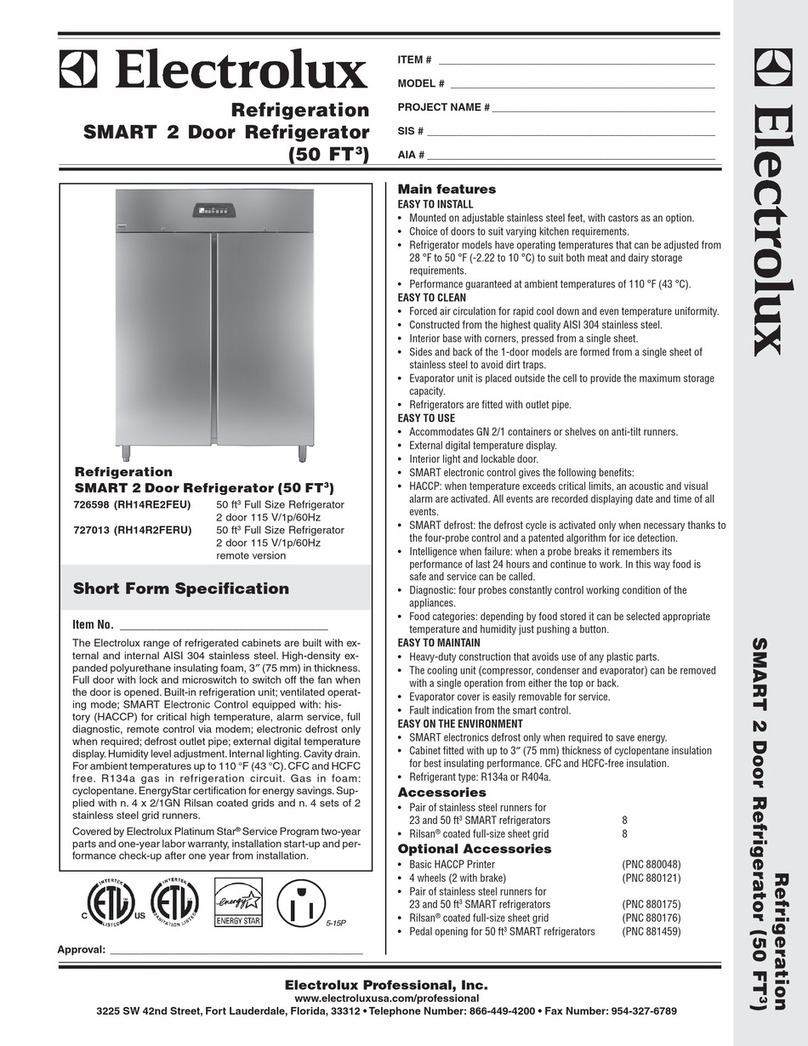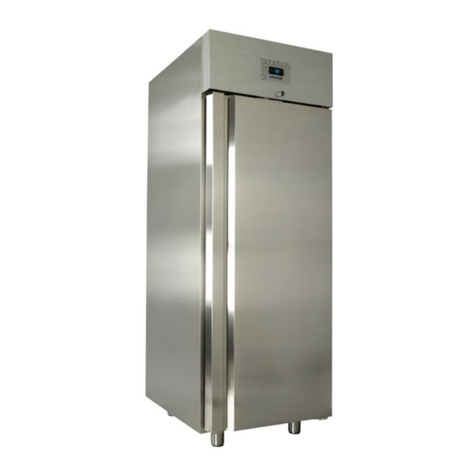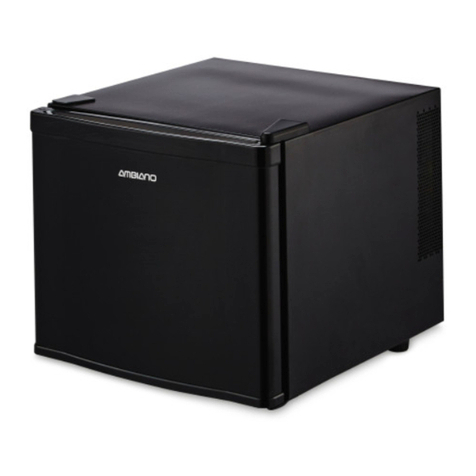DEVANTI BF-48L-WH User manual

INSTRUCTION MANUAL
REFRIGERATOR
MODEL: BF-48L-WH / BF-48L-SR
BF-70L-WH / BF-70L-SR
BF-95L-WH / BF-95L-SR
BF-48L-BK
BF-70L-BK
BF-95L-BK
BEFORE USE, PLEASE READ AND FOLLOW ALL SAFETY RULES AND OPERATING
INSTRUCTIONS.

1
IMPORTANT SAFETY INSTRUCTIONS
WARNING
To reduce the risk of fire, electrical shock, or injury
when using your refrigerator, follow these basic
precautions:
Read all instructions before using the refrigerator.
DANGER or WARNING: Risk of child entrapment.
Child entrapment and suffocation are not problems of the past. Junked or abandoned
refrigerators are still dangerous . . . even if they will “just sit in the garage a few days.”
Before you throw away your old refrigerator: Take off the door. Leave the shelves in
place so that children may not easily climb inside.
Never allow children to operate, play with, or crawl inside the refrigerator.
Never clean refrigerator parts with flammable fluids. The fumes can create a fire hazard or
explosion.
Do not store or use gasoline or any other flammable vapors and liquids in the vicinity of this
or any other refrigerator. The fumes can create a fire hazard or explosion.
This appliance is not intended for use by persons (including children)
with reduced physical, sensory or mental capabilities, or lack of
experience and knowledge, unless they have been given supervision or
instruction concerning use of the appliance by a person responsible for
their safety. Children should be supervised to ensure that they do not
play with the appliance.
If the supply cord is damaged, it must be replaced by the manufacturer,
its service agent or similarly qualified persons in order to avoid a hazard.
WARNING: Keep ventilation openings, in the appliance enclosure or in
the built-in structure, clear of obstruction.
WARNING: Do not use mechanical devices or other means to accelerate
the defrosting process, other than those recommended by the
manufacturer.
WARNING: Do not damage the refrigerant circuit.
WARNING: Do not use electrical appliances inside the food storage
compartments of the appliance, unless they are of the type
recommended by the manufacturer.
Do not store explosive substances such as aerosol cans with a
flammable propellant in this appliance.
This appliance is intended to be used in household and similar
applications such as:
– staff kitchen areas in shops, offices and other working environments;
– farm houses and by clients in hotels, motels and other residential type
environments;
– bed and breakfast type environments;
– catering and similar non-retail applications.

2
-Save these instructions-
Warnings related to disposal
The refrigerator's R600a refrigerant and cyclopentane foam materials are combustible materials and
discarded refrigerators should be isolated from fire sources and cannot be burned.
Please transfer the freezer to qualified professional recycling companies for processing to avoid
damages to the environment or other hazards.
Please remove the door of the refrigerator and shelves which shall be properly placed to avoid
accidents of children entering and playing in the refrigerator.
INSTALLATION INSTRUCTIONS
Before Using Your Refrigerator
Remove the exterior and interior packing.
Check to be sure you have all of the following part:
1 Instruction Manual
Before connecting the refrigerator to the power source, let it stand upright for approximately 2
hours. This will reduce the possibility of a malfunction in the cooling system from handling
during transportation.
Clean the interior surface with lukewarm water using a soft cloth.
Installing Your Refrigerator
This appliance is designed to be free standing only, and should not be recessed or built-in.
Place your refrigerator on a floor that is strong enough to support the refrigerator when it is
fully loaded. To level your refrigerator, adjust the leveling leg at the bottom of the refrigerator.
Allow 12 cm of space between the back and sides of the refrigerator, which allows the proper
air circulation to cool the compressor.
Locate the refrigerator away from direct sunlight and sources of heat (stove, heater, radiator,
etc.). Direct sunlight may affect the acrylic coating and heat sources may increase electrical
consumption. Extreme cold ambient temperatures may also cause the refrigerator not to
perform properly.
Avoid locating the refrigerator in moist areas.
Plug the refrigerator into an exclusive, properly installed-grounded wall outlet. Do not under
any circumstances cut or remove the third (ground) prong from the power cord. Any questions
concerning power and/or grounding should be directed toward a certified electrician or an
authorized service center.
After plugging the appliance into a wall outlet, allow the unit to cool down for 2-3 hours before
placing food in the refrigerator compartment.
Electrical Connection
Warning
Improper use of the grounded plug can result in the risk of electrical shock. If the power cord is
damaged, have it replaced by an authorized service center.

3
This refrigerator should be properly grounded for your safety. The power cord of this refrigerator is
equipped with a two-pin plug which mates with standard two prong wall outlets to minimize the
possibility of electrical shock.
Do not under any circumstances cut or remove the third ground prong from the power cord supplied.
This refrigerator requires a standard 220-240Volts A.C. ~/50Hz electrical outlet with two-prong
ground.
The cord should be secured behind the refrigerator and not left exposed or dangling to prevent
accidental injury.
Never unplug the refrigerator by pulling the power cord. Always grip the plug firmly and pull straight
out from the receptacle.
Do not use an extension cord with this appliance. If the power cord is too short, have a qualified
electrician or service technician install an outlet near the appliance.
OPERATING YOUR REFRIGERATOR
Setting the Temperature Control
To control the internal temperature, adjust the control dial according to the ambient
temperature or purpose of use.
The first time you turn the unit on, set the temperature control to “6.”
The range of the temperature control is from position "OFF” to “6”. After 24 to 48 hours,
adjust the temperature control to the setting that best suites your needs. The setting of “3”
should be appropriate for home or office refrigerator use.
NOTE:
If the unit is unplugged, has lost power, or is turned off; you must wait 3 to 5 minutes before
restarting the unit. If you attempt to restart before this time delay, the refrigerator will not start.
The Chiller Compartment
This compartment is designed for production of ice cubes and short-term storage (3-4 days at
most) of some commercially frozen foods.
The temperature in this compartment does not get cold enough to freeze food safely for long
periods of time and works best when the food is already frozen.
By design, this chiller compartment is NOT a true freezer, and may not keep ice cream frozen, or
freeze items.
A colder setting may be used for these items, but other items in the refrigerator may also be
affected.
The chiller door is susceptible to breaking due to excessive ice build up. This part is not covered
under your warranty. Be sure to defrost when the ice reaches ¼ inch thick.

4
CARE AND MAINTENANCE
Defrosting Your Refrigerator
Defrost the refrigerator when the frost accumulated on the evaporator is about 5mm (1/5 inch) thick.
Set the thermostat dial to “OFF” position. Remove frozen or perishable foods. Defrosting usually
takes a few hours. After defrosting, return the thermostat dial to the desired position. To defrost
quickly remove all foods from the refrigerator and leave the door open. Never use a knife or other
metal instrument to scrape ice/frost from the evaporator.
Cleaning Your Refrigerator
Turn the temperature control to "OFF", unplug the refrigerator, and remove the food, shelves,
and trays.
Wash the inside surfaces with a warm water and baking soda solution. The solution should be
about 2 tablespoons of baking soda to a quart of water.
Wash the shelves and trays with a mild detergent solution.
The outside of the refrigerator should be cleaned with mild detergent and warm water.
Wring excess water out of the sponge or cloth before cleaning the area of the controls, or any
electrical parts.
Wash the outside cabinet with warm water and mild liquid detergent. Rinse well and wipe dry
with a clean soft cloth.
Vacation Time
Short vacations: Leave the refrigerator operating during vacations of less than three weeks.
Long vacations: If the refrigerator will not be used for several months, remove all food and
unplug the power cord. Clean and dry the interior thoroughly. To prevent odor and mold growth,
leave the door open slightly: blocking it open if necessary.
Moving Your Refrigerator
Remove all the food.
Securely tape down all loose items inside your refrigerator.
Turn the leveling screw up to the base to avoid damage.
Tape the door shut.
Be sure the refrigerator stays secure in the upright position during transportation. Also
protect the outside of refrigerator with a blanket, or similar item.
Energy Saving Tips
The refrigerator should be located in the coolest area of the room, away from heat producing
appliances, and out of the direct sunlight.
Let hot foods cool to room temperature before placing in the refrigerator. Overloading the
refrigerator forces the compressor to run longer.
Be sure to wrap foods properly, and wipe containers dry before placing them in the
refrigerator. This cuts down on frost build-up inside the refrigerator.
Refrigerator storage bin should not be lined with aluminum foil, wax paper, or paper toweling.
Liners interfere with cold air circulation, making the refrigerator less efficient.
Organize and label food to reduce door openings and extended searches. Remove as many
items as needed at one time, and close the door as soon as possible.

5
PROBLEMS WITH YOUR REFRIGERATOR
You can solve many common refrigerator problems easily, saving you the cost of a possible service
call. Try the suggestions below to see if you can solve the problem before calling the servicer.
TROUBLESHOOTING GUIDE
PROBLEM
POSSIBLE CAUSE
Refrigerator does not operate.
Not plugged in.
The circuit breaker tripped or a blown fuse.
The refrigerator temperature control is set at
"OFF".
Turns on and off frequently.
The room temperature is hotter than normal.
A large amount of food has been added to the
refrigerator.
The door is opened too often.
The door is not closed completely.
The temperature control is not set correctly.
The door gasket does not seal properly.
The refrigerator does not have the correct
clearances.
Vibrations.
Check to assure that the refrigerator is level.
The refrigerator seems to make too much noise.
The rattling noise may come from the flow of the
refrigerant, which is normal.
As each cycle ends, you may hear gurgling
sounds caused by the flow of refrigerant in your
refrigerator.
Contraction and expansion of the inside walls
may cause popping and crackling noises.
The refrigerator is not level.
The door will not close properly.
The refrigerator is not level.
The door was reversed and not properly installed.
The gasket is dirty.
The shelves, bins, or baskets are out of position.
This manual suits for next models
8
Table of contents
Popular Refrigerator manuals by other brands

KitchenAid
KitchenAid KBFA20ER Technical education

Fisher & Paykel
Fisher & Paykel ActiveSmart RF522ADX4 manual

Viking
Viking FDSB5481D Series Planning and design guide
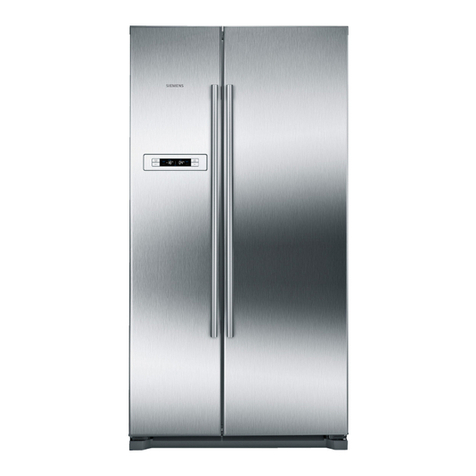
Siemens
Siemens KA90NVI30 Instructions for use and installation

Norcold
Norcold N620 Service manual
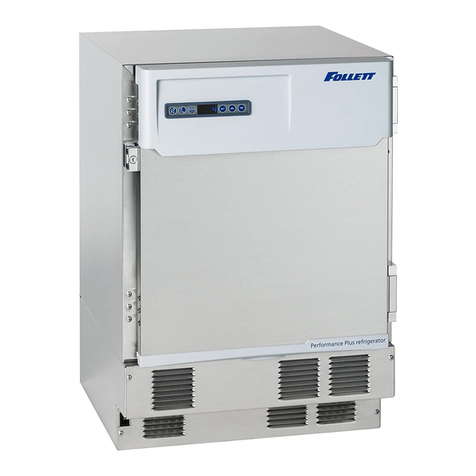
Follett
Follett REF4P Installation, operation and service manual

